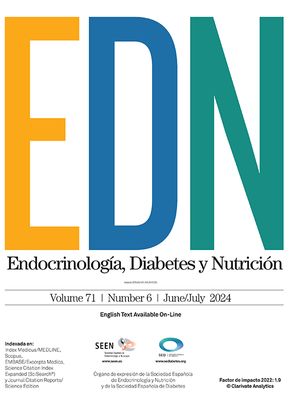To assess the effect of long-term strength training on insulin sensitivity, lipid profile, and body composition in overweight and obese subjects.
Materials and methodsA prospective, randomized, interventional study of 16 overweight or obese subjects aged 18–35 years who were investigated before and at the end of 8 weeks of strength training. The experimental group (n=8) followed a strength training program consisting of 4 sessions per week at 50% to 80% of repetition maximum (RM), estimated through the 1RM test. The control group (n=8) did not perform the training program. Glucose, insulin, total cholesterol, triglycerides, HDL-C, VLDL-C, and LDL-C levels and arterial index were determined. Insulin sensitivity was measured by calculating HOMA-IR (Homeostatic Model Assessment-Insulin Resistance). Indicators of body composition included weight, height, waist circumference, body fat, fat weight, muscle mass, somatotype chart and distance.
ResultsAt the end of intervention, the experimental group showed decreased insulin sensitivity (3.5±0.9 vs. 2.9±1.2; p=0.04), LDL-C (106.9±20.8 vs. 95.5±14.2; p=0.03) and arterial index (4.0±0.6 vs. 3.5±0.5; p=0.01) values and increased HDL-C levels (43.7±8.8 vs. 46.9±5.6; p=0.04), while the control group remained stable. There were no significant differences between the groups regarding body composition, somatotype chart or distance after training.
ConclusionsIn overweight and obese subjects, strength training for eight weeks improved insulin sensitivity and lipid profile without altering body composition.
Evaluar el efecto del entrenamiento con pesas a largo plazo en la sensibilidad a la insulina, el perfil lipídico y la composición corporal en sujetos con sobrepeso y obesidad.
Materiales y métodosEstudio prospectivo de intervención y aleatorizado en 16 sujetos con sobrepeso u obesidad entre los 18 y los 35 años de edad, distribuidos aleatoriamente en dos grupos: a) grupo experimental (n=8), 6 semanas de entrenamiento con pesas, 4 sesiones/semana, a intensidades entre el 50 y el 80% de la repetición máxima (RM), obtenida a través de la prueba de 1RM, y b) grupo control (n=8), que no desarrolló el programa de entrenamiento. Se evaluaron los valores de glucosa, insulina, colesterol total, triglicéridos, colesterol unido a lipoproteínas de alta densidad (cHDL), colesterol unido a lipoproteínas de muy baja densidad, colesterol unido a lipoproteínas de baja densidad (cLDL) e índice arterial. La sensibilidad a la insulina se determinó mediante el cálculo del índice HOMA-RI (del inglés Homeostatic Model Assessment–Insulin Resistance). Los indicadores de composición corporal y antropométrica fueron peso, talla, circunferencia de cintura, grasa corporal, peso graso, masa muscular, carta y distancia somatotípica.
ResultadosAl finalizar la intervención, se observó en el grupo experimental una disminución de la sensibilidad a la insulina (3,5±0,9 frente a 2,9±1,2; p=0,04); cLDL (106,9±20,8 frente a 95,5±14,2; p=0,03) e índice arterial (4,0±0,6 frente a 3,5±0,5; p=0,01), así como un aumento de cHDL (43,7±8,8 frente a 46,9±5,6; p=0,04), mientras que en el grupo control no se evidenciaron cambios. No se observaron diferencias significativas en la composición corporal, carta y distancia somatotípica tras el entrenamiento en ninguno de los dos grupos.
ConclusionesEn sujetos con sobrepeso y obesidad, el entrenamiento con pesas durante 8 semanas mejora la sensibilidad a la insulina y el perfil lipídico sin alterar la composición corporal.




